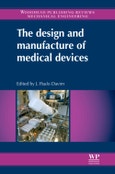Medical devices play an important role in the field of medical and health technology, and encompass a wide range of health care products. Directive 2007/47/EC defines a medical device as any instrument, apparatus, appliance, software, material or other article, whether used alone or in combination, including the software intended by its manufacturer to be used specifically for diagnostic and/or therapeutic purposes and necessary for its proper application, intended by the manufacturer to be used for human beings. The design and manufacture of medical devices brings together a range of articles and case studies dealing with medical device R&D. Chapters in the book cover materials used in medical implants, such as Titanium Oxide, polyurethane, and advanced polymers; devices for specific applications such as spinal and craniofacial implants, and other issues related to medical devices, such as precision machining and integrated telemedicine systems.
Please Note: This is an On Demand product, delivery may take up to 11 working days after payment has been received.
Table of Contents
List of figures
List of tables
Preface
About the contributors
Chapter 1: Characteristics and applications of titanium oxide as a biomaterial for medical implants
Abstract:
1.1 Introduction
1.2 Classification of biomaterials
1.3 Biomedical implantable devices
1.4 Applications
1.5 Proteins
1.6 Titanium oxide
Chapter 2: Precision machining of medical devices
Abstract:
2.1 Metallurgical aspects
2.2 Principal requirements of medical implants
2.3 Shape memory alloys
2.4 Conclusions
2.5 Acknowledgment
Chapter 3: Polyurethane for biomedical applications: A review of recent developments
Abstract:
3.1 Introduction
3.2 Biocompatibility evaluation
3.3 Biostability evaluation
3.4 Polyurethane for drug-controlled delivery
3.5 Polyurethane for cardiovascular applications
3.6 Polyurethane for medical supplies
3.7 Future outlook
Chapter 4: Application of the finite element method in spinal implant design and manufacture
Abstract:
4.1 Introduction to finite element method
4.2 General aspects of FEM
4.3 Parts of the finite element model of the spine
4.4 Verification
4.5 Validation
4.6 Application of the FEM in implant design
4.7 Conclusions
Chapter 5: Design and manufacture of a novel dynamic spinal implant
Abstract:
5.1 Introduction
5.2 Materials and methods
5.3 Results
5.4 Discussion
5.5 Conclusion
5.6 Acknowledgment
Chapter 6: Customized craniofacial implants: Design and manufacture
Abstract:
6.1 Introduction
6.2 The anatomic biomodels and craniofacial reconstruction
6.3 Biomodels and the design of customized prostheses
Chapter 7: Technological advances for polymers in active implantable medical devices
Abstract:
7.1 Introduction
7.2 Polymers as an alternative to metals
7.3 Challenges for implementing polymer components in AIMDs
7.4 Conclusions
Chapter 8: Integrated telemedicine systems: Patient monitoring, in-time prognostics, and diagnostics at domicile
Abstract:
8.1 Introduction
8.2 State of the art of telemedicine systems
8.3 Architecture
8.4 Implementation
8.5 Experimental results
8.6 Conclusions
Index








